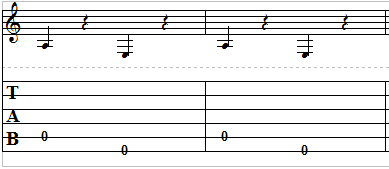Below is the tab for our first alternating bass exercise. Use your thumb to pick each note. You should also count along to the beat with 1, 2, 3, 4, 1, 2, 3, 4 to help you keep time. Each note lasts one beat, then rest one beat, play the next note one beat, and then rest one beat.
For example, play the A string one beat, rest one beat, play the E string one beat, rest one beat, and repeat.

This bouncing bass line that we’re playing is the foundation of alternating bass. In most alternating bass lines we are simply changing the lowest note back and forth from the root note to the 5th.
In our example exercise, the bass line would be for an A chord. Don’t worry, this part will make more sense to you in a future step when we add the rest of the chord voicing.
The A note is our root note. It’s the lowest note and foundation of the chord. It’s 5th, being the 5th scale step in the A major scale, is E. So, for an A chord, we’ll alternate between A and E.
You can also try variations. Try alternating between the open D string and the open A string just like we did with A and E. Start on the D note. This would be for a D chord.
Next, try alternating between the C on the 3rd fret of the A string and the G on the 3rd fret of low E string. This would be an alternating bass line for a C chord.